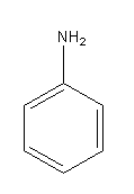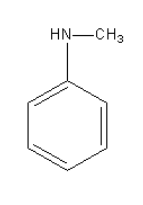
Which of the following compounds react with \[{\text{NaN}}{{\text{O}}_{\text{2}}}\] and \[{\text{HCl}}\] at \[{\text{0 - 4}}^\circ {\text{C}}\] to give alcohol/phenol?
A. \[{{\text{C}}_{\text{6}}}{{\text{H}}_{\text{5}}}{\text{N}}{{\text{H}}_{\text{2}}}\]
B. \[{{\text{C}}_2}{{\text{H}}_{\text{5}}}{\text{N}}{{\text{H}}_{\text{2}}}\]
C. \[{\text{C}}{{\text{H}}_3}{\text{NHC}}{{\text{H}}_3}\]
D. \[{{\text{C}}_{\text{6}}}{{\text{H}}_{\text{5}}}{\text{NHC}}{{\text{H}}_{\text{3}}}\]
Answer
560.4k+ views
Hint: The reagent \[{\text{NaN}}{{\text{O}}_{\text{2}}}\] and \[{\text{HCl}}\] used to distinguish primary, secondary and tertiary amines. Only primary aliphatic amines react with \[{\text{NaN}}{{\text{O}}_{\text{2}}}\] and \[{\text{HCl}}\] at \[{\text{0 - 4}}^\circ {\text{C}}\] . The product of the reaction is alcohol.
Complete Step by step answer: The reagent given to us is \[{\text{NaN}}{{\text{O}}_{\text{2}}}\] and \[{\text{HCl}}\] and the reaction condition is \[{\text{0 - 4}}^\circ {\text{C}}\]. Only primary aliphatic amines react with \[{\text{NaN}}{{\text{O}}_{\text{2}}}\] and \[{\text{HCl}}\] at \[{\text{0 - 4}}^\circ {\text{C}}\] and give alcohol as the product.
The amine given in option A is \[{{\text{C}}_{\text{6}}}{{\text{H}}_{\text{5}}}{\text{N}}{{\text{H}}_{\text{2}}}\]. Its structure is as follows:

It is aromatic amine so it will not give phenol after reacting with \[{\text{NaN}}{{\text{O}}_{\text{2}}}\] in \[{\text{HCl}}\] at \[{\text{0 - 4}}^\circ {\text{C}}\].
Thus, option (A) \[{{\text{C}}_{\text{6}}}{{\text{H}}_{\text{5}}}{\text{N}}{{\text{H}}_{\text{2}}}\] is incorrect.
The amine given in option B is\[{{\text{C}}_2}{{\text{H}}_{\text{5}}}{\text{N}}{{\text{H}}_{\text{2}}}\]. Its structure is as follows:

It is a primary aliphatic amine so it will give alcohol after reacting with \[{\text{NaN}}{{\text{O}}_{\text{2}}}\] in \[{\text{HCl}}\] at \[{\text{0 - 4}}^\circ {\text{C}}\].
So, option (B) \[{{\text{C}}_2}{{\text{H}}_{\text{5}}}{\text{N}}{{\text{H}}_{\text{2}}}\]is correct.
The amine given in option C is \[{\text{C}}{{\text{H}}_3}{\text{NHC}}{{\text{H}}_3}\]. Its structure is as follows:

It is secondary aliphatic amine so it will not give alcohol after reacting with \[{\text{NaN}}{{\text{O}}_{\text{2}}}\] in \[{\text{HCl}}\] at \[{\text{0 - 4}}^\circ {\text{C}}\].
Thus, option (C) \[{\text{C}}{{\text{H}}_3}{\text{NHC}}{{\text{H}}_3}\] is incorrect.
The amine given in option D is \[{{\text{C}}_{\text{6}}}{{\text{H}}_{\text{5}}}{\text{NHC}}{{\text{H}}_{\text{3}}}\]. Its structure is as follows:

It is aromatic secondary amine so it will not give phenol after reacting with \[{\text{NaN}}{{\text{O}}_{\text{2}}}\] in \[{\text{HCl}}\] at \[{\text{0 - 4}}^\circ {\text{C}}\].
Thus, option (D) \[{{\text{C}}_{\text{6}}}{{\text{H}}_{\text{5}}}{\text{NHC}}{{\text{H}}_{\text{3}}}\] is incorrect.
Hence, option (B) \[{{\text{C}}_2}{{\text{H}}_{\text{5}}}{\text{N}}{{\text{H}}_{\text{2}}}\]is the correct answer.
Note: Aliphatic primary amines react with\[{\text{NaN}}{{\text{O}}_{\text{2}}}\] in \[{\text{HCl}}\] at \[{\text{0 - 4}}^\circ {\text{C}}\]and undergo diazotization to form alkane diazonium salt, which however being unstable decomposes to form a mixture of alcohols, alkene with the liberation of \[{{\text{N}}_{\text{2}}}\] gas. Secondary amines react with \[{\text{NaN}}{{\text{O}}_{\text{2}}}\] in \[{\text{HCl}}\] to form N-nitrosamines.
Complete Step by step answer: The reagent given to us is \[{\text{NaN}}{{\text{O}}_{\text{2}}}\] and \[{\text{HCl}}\] and the reaction condition is \[{\text{0 - 4}}^\circ {\text{C}}\]. Only primary aliphatic amines react with \[{\text{NaN}}{{\text{O}}_{\text{2}}}\] and \[{\text{HCl}}\] at \[{\text{0 - 4}}^\circ {\text{C}}\] and give alcohol as the product.
The amine given in option A is \[{{\text{C}}_{\text{6}}}{{\text{H}}_{\text{5}}}{\text{N}}{{\text{H}}_{\text{2}}}\]. Its structure is as follows:

It is aromatic amine so it will not give phenol after reacting with \[{\text{NaN}}{{\text{O}}_{\text{2}}}\] in \[{\text{HCl}}\] at \[{\text{0 - 4}}^\circ {\text{C}}\].
Thus, option (A) \[{{\text{C}}_{\text{6}}}{{\text{H}}_{\text{5}}}{\text{N}}{{\text{H}}_{\text{2}}}\] is incorrect.
The amine given in option B is\[{{\text{C}}_2}{{\text{H}}_{\text{5}}}{\text{N}}{{\text{H}}_{\text{2}}}\]. Its structure is as follows:

It is a primary aliphatic amine so it will give alcohol after reacting with \[{\text{NaN}}{{\text{O}}_{\text{2}}}\] in \[{\text{HCl}}\] at \[{\text{0 - 4}}^\circ {\text{C}}\].
So, option (B) \[{{\text{C}}_2}{{\text{H}}_{\text{5}}}{\text{N}}{{\text{H}}_{\text{2}}}\]is correct.
The amine given in option C is \[{\text{C}}{{\text{H}}_3}{\text{NHC}}{{\text{H}}_3}\]. Its structure is as follows:

It is secondary aliphatic amine so it will not give alcohol after reacting with \[{\text{NaN}}{{\text{O}}_{\text{2}}}\] in \[{\text{HCl}}\] at \[{\text{0 - 4}}^\circ {\text{C}}\].
Thus, option (C) \[{\text{C}}{{\text{H}}_3}{\text{NHC}}{{\text{H}}_3}\] is incorrect.
The amine given in option D is \[{{\text{C}}_{\text{6}}}{{\text{H}}_{\text{5}}}{\text{NHC}}{{\text{H}}_{\text{3}}}\]. Its structure is as follows:

It is aromatic secondary amine so it will not give phenol after reacting with \[{\text{NaN}}{{\text{O}}_{\text{2}}}\] in \[{\text{HCl}}\] at \[{\text{0 - 4}}^\circ {\text{C}}\].
Thus, option (D) \[{{\text{C}}_{\text{6}}}{{\text{H}}_{\text{5}}}{\text{NHC}}{{\text{H}}_{\text{3}}}\] is incorrect.
Hence, option (B) \[{{\text{C}}_2}{{\text{H}}_{\text{5}}}{\text{N}}{{\text{H}}_{\text{2}}}\]is the correct answer.
Note: Aliphatic primary amines react with\[{\text{NaN}}{{\text{O}}_{\text{2}}}\] in \[{\text{HCl}}\] at \[{\text{0 - 4}}^\circ {\text{C}}\]and undergo diazotization to form alkane diazonium salt, which however being unstable decomposes to form a mixture of alcohols, alkene with the liberation of \[{{\text{N}}_{\text{2}}}\] gas. Secondary amines react with \[{\text{NaN}}{{\text{O}}_{\text{2}}}\] in \[{\text{HCl}}\] to form N-nitrosamines.
Recently Updated Pages
Master Class 11 Economics: Engaging Questions & Answers for Success

Master Class 11 English: Engaging Questions & Answers for Success

Master Class 11 Social Science: Engaging Questions & Answers for Success

Master Class 11 Biology: Engaging Questions & Answers for Success

Class 11 Question and Answer - Your Ultimate Solutions Guide

Master Class 11 Business Studies: Engaging Questions & Answers for Success

Trending doubts
What is meant by exothermic and endothermic reactions class 11 chemistry CBSE

10 examples of friction in our daily life

One Metric ton is equal to kg A 10000 B 1000 C 100 class 11 physics CBSE

Difference Between Prokaryotic Cells and Eukaryotic Cells

What are Quantum numbers Explain the quantum number class 11 chemistry CBSE

1 Quintal is equal to a 110 kg b 10 kg c 100kg d 1000 class 11 physics CBSE




